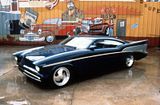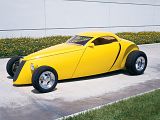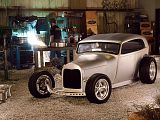Boyd Coddington
Boyd Leon Coddington (Born in Rupert, Idaho on August 28, 1944 – February 27, 2008)[1] was the owner of the Boyd Coddington Hot Rod Shop, Boyd Codding Wheels and star of American Hot Rod cable TV show. BackgroundCoddington grew up in Rupert, Idaho, reading all the car and hot rod magazines he could, and got his first car (a 1931 Chevrolet truck) at age 8.[2] He attended machinist trade school at Idaho State University and completed a three-year apprenticeship in machining. In 1968, he moved to California building hot rods by night and working as a machinist at Disneyland during the day. He soon became known for building unique hot rods and in 1977 he opened his own shop, Hot Rods by Boyd, in Cypress, California. He realized quick success: his first major customer was Vern Luce whose car, a 1933 coupe, won the Al Slonaker Award at the 1981 Oakland Roadster show. Design innovationsCoddington's clean, elegant aesthetic married modern automotive streamlining to the classic forms of 1930s to 1960s American iron.[3] It featured radically transformed vintage styling, but re-engineered around modern and scratch-built components: at the customer's preference a George Barris-style body could sit atop a chassis with the comfort and accessories of a modern luxury vehicle, or around the roll cage and open pipes of a salt-flats racer. One of Coddington's signature innovations were his custom-fabricated alloy wheels, typically machined from a solid billet (block) of aluminum (an industry first). Boyd pioneered this 'billet' machined look and applied it not only to wheels but broadly throughout the car[4]. In 1988, Coddington founded Boyd's Wheels, Inc., to manufacture and market these custom billet wheels. His popularization of machined billet wheels had broad impact, eventually spreading out of the hot rod world to enormously influence the popularity of custom rims within hip-hop culture. Among his many innovative designs was a unique set of wheels commissioned for the Chevrolet Camaro RS/SS. Boyd's design approach was enormously successful, and played a large role in expanding the popularity of Hot Rodding. As opposed to its previous zenith among the youth of the 1940's to early 1970's, its resurgence in the 90's was among an older crowd -- those selfsame youth, nostalgic for classic styling but demanding modern appointments, and now with the checkbook to pay for both. This eventually led to excess of its own. In later year most cars competing for top awards represented major commissions involving multiple firms (Coddington's frequently among them), custom-designed parts and price tags often over half a million dollars. In the process this priced out much of the hobby's grass-roots appeal. From a design standpoint as well, many consider that the modern hot-rod aesthetic has led to austere cookie-cutter trailer queens; the current "Rat Rod" movement in hotrodding explicitly refutes this immoderation. Some of Coddington's work is considered bland and dated in rat rod traditional hot rod circles, particularly his earlier work. Still, to the end of his career (and continuing currently), those with the means to do so have eagerly sought Coddington's services and products. His major works continue to be held in high regard, and throughout his career he ranked among his industry's top practitioners, both commercially and artistically. CadZZillaThere is no better demonstration of Coddington's design aesthetic than his masterwork, "CadZZilla". Commissioned by ZZ Top's Billy Gibbons and designed by Larry Erickson[5], CadZZilla is universally acclaimed as one of the greatest expressions of automotive customization[6]. Renowned columnist Gray Baskerville called CadZZilla "the most incredible transformation he’d ever witnessed"[5], and in their "History of Hot Rods & Customs" the auto editors of Consumer Guide praise it as "the first really new type of custom since the heyday of the 1950s"[4] Artistic legacyMany of the next generation of customizers started their career with Coddington. Larry Erickson, later the Chief Designer of the Mustang and Thunderbird for Ford Motor Co., worked with Coddington early on, and specifically credits the CadZZilla collaboration for jump-starting his career[7]. Legendary designer (and "Overhaulin'" star) Chip Foose, and fabricator (and "Motorcycle Mania" star) Jesse James [8] both started their careers in his shop. Foose rose to become the president of Coddington's company Hot Rods by Boyd, but later departed to start his own firm. The two became fierce competitors, to the point that their personal relationship split.[9] Coddington hosted the Discovery Channel show “American Hot Rod", where he competed fiercely as well with his former protegé. Coddington's creations have won the Grand National Roadster Show's "America's Most Beautiful Roadster (AMBR)" award seven times, the Daimler-Chrysler Design Excellence award twice, and entry into both the Grand National Roadster Show Hall of Fame and the National Rod & Custom Museum Hall of Fame[10] . In 1997, Coddington (along with Foose), was inducted into the Hot Rod Hall of Fame[11]. Later financial trouble and the "Ship of Theseus"In 1998, financial trouble and a $465,000 writeoff of money due from a bankrupt customer led Coddington to re-organize Boyds Wheels.[11] [12] More seriously, in 2005 Coddington's design aesthetic and some questionable judgement gave rise to severe epistemic and financial difficulties. His designs, as has been said, centrally feature scratch-built components and appropriated parts to extensively modify the foundation of a vintage automobile. In his later days he began registering cars that were essentially completely custom fabrications as antique automobiles, avoiding major emissions restrictions and tax liabilities. California officials considered this a "Ship of Theseus" fraud, claiming that so many central elements were replaced the cars ceased to be the same entity. Coddington was charged with a misdemeanor and plead guilty on April 7, 2005.[13] DeathCoddington had been hospitalized December 31, 2007 shortly after New Year's Eve. (?)[14] He was discharged, but was readmitted just a few days later to Presbyterian Intercommunity Hospital in suburban Whittier, California. After being readmitted, doctors performed surgery and Boyd was expected to make a complete recovery. Coddington died on February 27, 2008. His publicist stated that Coddington was a long-time diabetic who died from complications that were brought on from a recent surgery along with liver and kidney complications.[15]
References
External links
|
    |
||||||||||||||||||||||||||||








